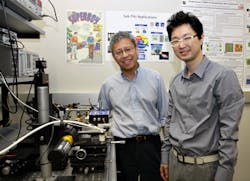Richardson, TX--Researchers at The University of Texas at Dallas (UT Dallas) have designed an imaging chip or microchip that could turn mobile phones into devices that can see through walls, wood, plastics, paper, and other opaque objects. By combining terahertz (THz) technology and complementary metal-oxide semiconductor (CMOS) advances, the images can be created with signals operating in the terahertz range without having to use several lenses inside a device, reducing overall size and cost.
"We've created approaches that open a previously untapped portion of the electromagnetic spectrum for consumer use and life-saving medical applications," said Kenneth O, professor of electrical engineering at UT Dallas and director of the Texas Analog Center of Excellence (TxACE). "CMOS is affordable and can be used to make lots of chips," O said. "The combination of CMOS and terahertz means you could put this chip and a transmitter on the back of a cellphone, turning it into a device carried in your pocket that can see through objects."
Due to privacy concerns, O and his team are focused on uses in the distance range of less than four inches. Consumer applications of terahertz technology could range from finding studs in walls to authentication of important documents. Businesses could use it to detect counterfeit money. Manufacturing companies could apply it to process control. There are also more communication channels available in terahertz than the range currently used for wireless communication, so information could be more rapidly shared at this frequency. Terahertz can also be used for imaging to detect cancer tumors, diagnosing disease through breath analysis, and monitoring air toxicity.
The team will work next to build an entire working imaging system based on the CMOS terahertz system. The work was supported by the Center for Circuit & System Solutions (C2S2 Center) and conducted in the TxACE laboratory at UT Dallas, which is funded by the Semiconductor Research Corporation (SRC), the state through its Texas Emerging Technology Fund, Texas Instruments Inc., The UT System and UT Dallas.
SOURCE: The University of Texas at Dallas;www.utdallas.edu/news/2012/4/18-17231_New-Research-Could-Mean-Cellphones-That-Can-See-Th_article-wide.html

